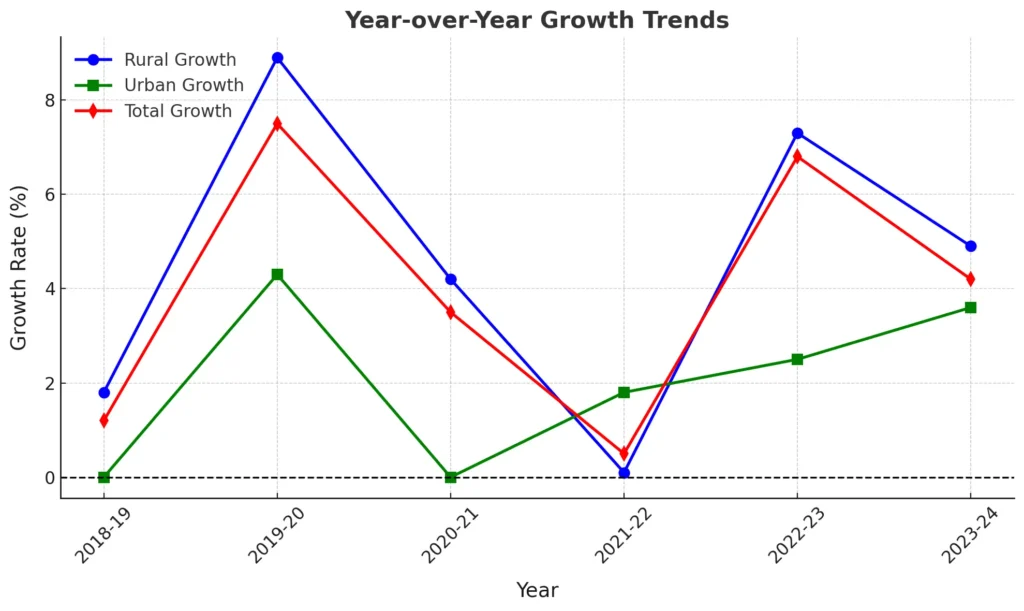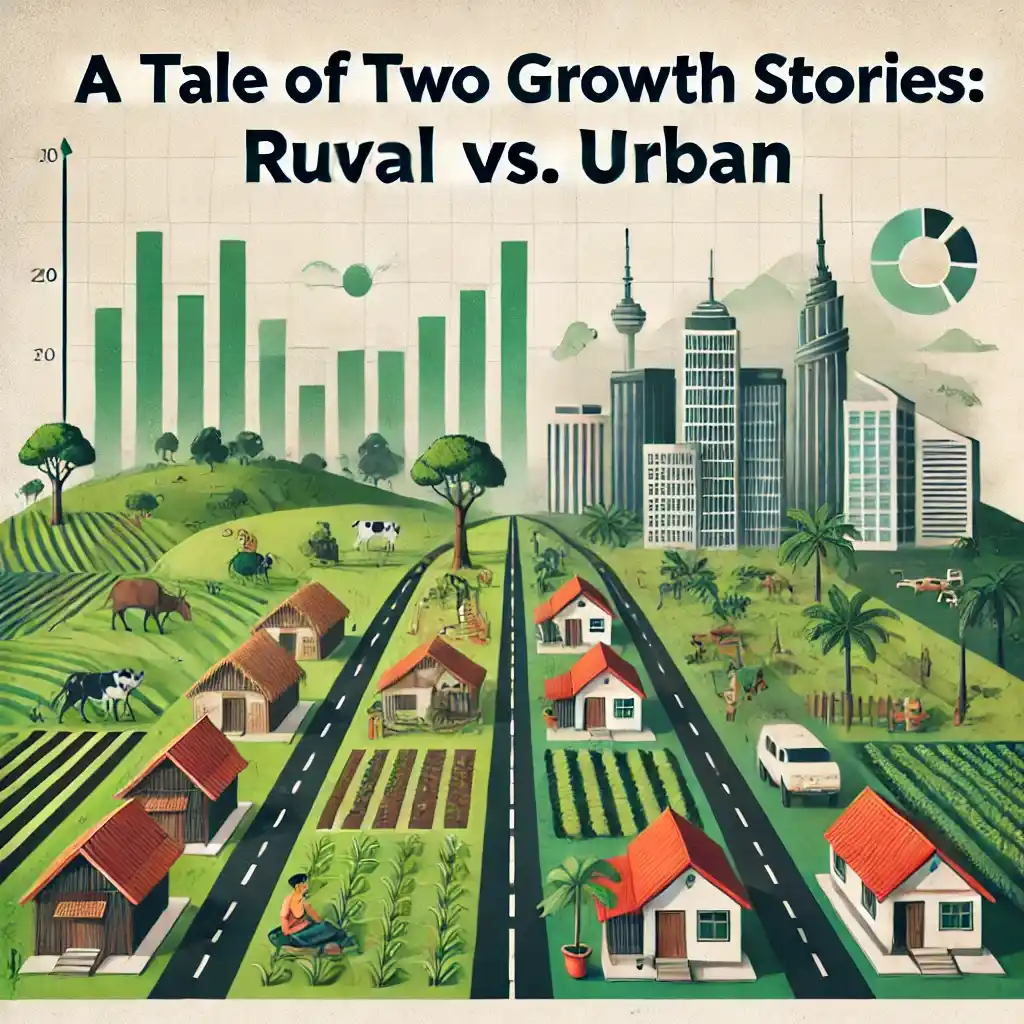“Efficiency is doing things right; effectiveness is doing the right things.” – Peter Drucker
Are More Jobs Always a Sign of Progress?
Understanding economic growth is not just about looking at employment numbers; it is about analyzing whether these jobs contribute to real productivity. Many might hear that employment in rural India has surged while urban job growth has been slow, and assume this means that rural areas are thriving while urban employment struggles. But the real question is, does an increase in employment necessarily mean people are actually being productive, or are we just seeing a different form of disguised unemployment?
The Numbers Behind India’s Employment Shift
The Worker Population Ratio (WPR), which tracks employment trends in both rural and urban areas, paints a picture that challenges common perceptions about job creation. The dataset used for this analysis comes from data.gov.in, which provides year-wise details of WPR, indicating employment trends among the salaried class under the usual status approach.
Between 2017-18 and 2023-24, rural employment increased significantly from 48.1% to 62.1%, while urban employment saw only a marginal rise from 43.9% to 49.4%. On the surface, it might seem like the rural workforce is growing rapidly due to an expanding economy, but a closer look reveals that much of this growth is driven by government schemes and short-term policies rather than organic job creation. This means that instead of real economic progress, many of these jobs exist because they are being artificially created, not because the market needs them. Meanwhile, urban employment numbers remain steady, not because opportunities are lacking, but because industries are evolving in a way that doesn’t require as many additional workers.
Visualizing Year-over-Year Growth Trends
To better understand these employment shifts, the following graph presents year-over-year employment growth trends for rural, urban, and total employment.

Source: Generated by author using the dataset from data.gov.in.
This visualization highlights several key insights:
- 2019-20 saw a sharp rise in rural employment growth, significantly outpacing urban employment. This increase likely reflects policy-driven job creation rather than the actual market demand.
- 2020-21 showed stagnation, particularly in urban areas, due to the economic downturn caused by the pandemic.
- A strong recovery was observed in 2022-23, where rural employment again saw the highest spike, while urban employment grew at a slower pace.
- Urban employment growth is more stable, while rural employment fluctuates sharply, indicating a greater dependence on external factors such as government policies or economic disruptions.
The Rural-Urban Employment: Different but Same
According to the above visualization, one can infer that rural employment growth appears to be policy-driven, fueled by government job schemes, rural infrastructure expansion, and agricultural support measures. On the other hand, urban employment growth remains sluggish yet stable, constrained by structural challenges in the formal sector, slow job creation in industries, and increasing automation. However, these trends should not be examined in isolation. A closer look at employment quality reveals a deeper issue—disguised employment in rural areas and disguised unemployment in urban settings.
Understanding Disguised Employment and Disguised Unemployment
Disguised employment occurs when people have jobs, but their work does not meaningfully contribute to economic output. This often results from government interventions that create employment opportunities without driving real productivity gains. On the other hand, disguised unemployment refers to situations where workers remain employed, but their skills or efforts are underutilized, meaning their removal would not significantly impact total output.
Rural Job Expansion: Real or Illusory?
A deeper analysis of rural employment trends reveals volatile patterns. In 2019-20, rural WPR (Worker Population Ratio) grew by 8.99%, yet by 2021-22, growth stagnated at just 0.18%. This suggests that job expansion is temporary and primarily driven by policy interventions rather than sustainable economic activity.
This pattern aligns with disguised employment, where jobs exist but do not contribute to real productivity growth. Government schemes like MGNREGA, while crucial for social security, often focus on employment for the sake of employment rather than fostering sustainable economic development. As a result, while rural employment figures may show growth, they do not necessarily indicate real economic progress.
Urban Workforce: Efficiency vs. Headcount
While urban employment growth appears sluggish, this does not necessarily signal a job crisis. Instead, it highlights structural inefficiencies, slow job creation in high-skill industries, and rigid labor markets.
Post-pandemic, many businesses retained large workforces despite efficiency gains from remote and hybrid work models. A significant proportion of salaried employees engage in redundant tasks, contributing to what can be termed modern corporate disguised unemployment. Because, the pandemic demonstrated that a significant percentage of work can be done remotely, and does not require 9-12 hours of physical presence. Additionally, skill mismatches and outdated corporate hierarchies prevent organizations from optimizing workforce productivity, further exacerbating inefficiencies. Many firms cling to a control-and-surveillance mentality, fearing that remote employees will slack off without constant oversight. However, evidence suggests the opposite—employees working remotely either complete tasks efficiently to enjoy free time or work harder to maintain flexibility, fostering self-discipline and higher productivity. Traditional corporate structures also struggle to adapt to a workforce that prioritizes results over rigid work hours. Younger professionals, being more tech-savvy and goal-driven, are drawn to companies that offer autonomy, leading firms that resist flexibility to lose talent to more progressive competitors. Moreover, the belief that physical office presence is necessary for collaboration ignores the success of fully remote firms like GitLab and Zapier, which sustain innovation through structured yet flexible teamwork models.
Financial and security concerns further reinforce inefficiencies. Many companies justify forcing employees back into offices simply because of past real estate investments, yet flexible workspace models like co-working spaces and hot-desking could reduce unnecessary costs. Likewise, modern cybersecurity solutions—such as Zero Trust models, VPNs, and encrypted cloud storage—effectively safeguard remote operations, making the argument for mandatory office presence increasingly obsolete. Ultimately, businesses must transition to hybrid flexibility, invest in digital tools, and adopt output-based performance metrics. Those clinging to outdated work structures risk declining efficiency, while companies that embrace change will thrive in the evolving corporate landscape.
Thus, while rural employment expansion may be policy-driven disguised employment, urban employment struggles with overstaffing and structural inefficiencies, leading to disguised unemployment.
Employment Growth vs. Productivity: The Real Question
The key takeaway from this analysis is that employment growth alone is not a sufficient measure of economic progress. Disguised employment and disguised unemployment manifest differently in rural and urban settings:
- Rural employment growth is volatile and policy-dependent, often leading to inefficiencies rather than sustained productivity.
- Urban job stability does not always equate to productivity, as many corporate roles involve redundant or underutilized tasks.
The Path Forward: Rethinking Employment for Real Progress
India’s employment trends highlight an important issue: job numbers alone do not reflect real economic progress. The focus should be on whether those jobs are truly contributing to productivity. Without this shift in perspective, India risks fostering a workforce that is employed but not necessarily progressing.
To move forward:
- Rural employment should transition from temporary, government-driven work to sustainable industries that generate long-term economic value.
- Urban workplaces must embrace efficiency and innovation, moving beyond outdated job structures and improving workforce utilization.
Only by addressing both disguised employment and disguised unemployment can India achieve meaningful and sustainable economic growth.


Intriguing perspective